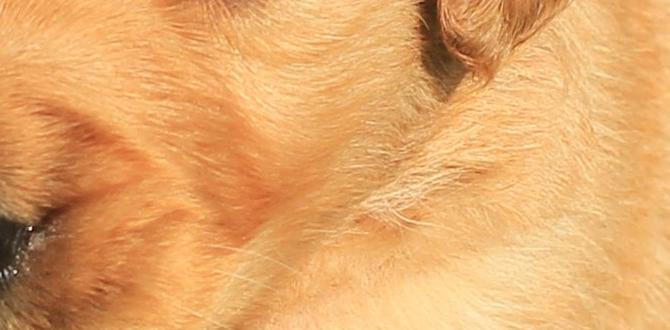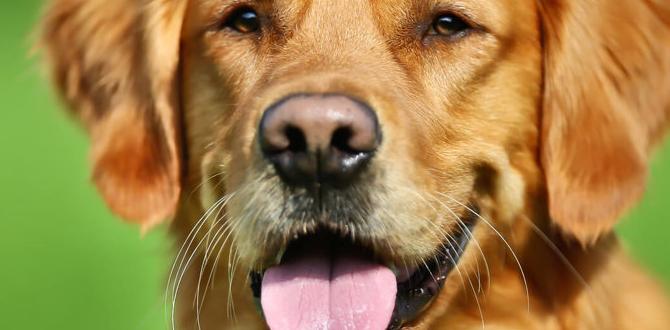Have you ever noticed your dog’s behavior around food? Many dogs guard their food naturally. This can seem strange to us. Why would a dog do this? It’s part of their instincts to protect what’s theirs. Let’s dive into why dogs act this way and what it means.
Key Takeaways
- Dogs naturally guard their food to protect their resources.
- Food guarding is common and not always a sign of aggression.
- Understanding this behavior helps improve your dog’s trust.
- Training can reduce food guarding in dogs.
- Not all dogs will guard their food naturally.
Why Do Dogs Guard Food?
Dogs guard food because of their natural instincts. In the wild, food is a valuable resource. Animals protect it to survive. Even though our pet dogs are not wild, they still have these instincts. When a dog guards food, it might growl or stand over its bowl. This does not mean the dog is aggressive. It’s just trying to keep its food safe. Understanding this behavior is key to a happy relationship with your dog.
- Food is a resource for survival.
- Dogs use body language to guard.
- Guarding is more common in multiple-dog homes.
- Some dogs are more protective than others.
- Recognizing signs can prevent problems.
To reduce food guarding, it’s important to build trust with your dog. You can teach your dog that food is always available. This can help reduce their need to guard. Training and patience are important. Always approach your dog calmly. This shows them they can trust you.
Fun Fact or Stats : Did you know that dogs have been guarding food for thousands of years? It’s a behavior passed down from their wild ancestors.
What Triggers Food Guarding?
Food guarding is triggered by a sense of scarcity. When food seems limited, dogs protect it more. Have you ever had to share your favorite snack? You might want to keep it all to yourself! Dogs feel the same way about their food. They think, “I need this to survive!” This behavior is natural and helps them feel secure.
How to Recognize Food Guarding?
Recognizing food guarding is important for safety. Look for signs like growling or stiff body posture. If a dog is guarding food, it might not want you near its bowl. Imagine you have a special toy, and someone tries to take it. You might hold it closer. Dogs do the same with food. Approaching carefully can help prevent issues.
Is Food Guarding Common?
Yes, food guarding is common in many dogs. However, not all dogs show this behavior. Each dog is unique. Some might never guard their food. Others do it often. Understanding your dog’s behavior helps you handle situations better. It’s like knowing your friend’s habits. You learn what makes them happy or upset.
How to Manage Food Guarding?
Managing food guarding takes patience and understanding. Start by creating a safe environment. Give your dog its own space to eat without distractions. Avoid taking food away suddenly. Instead, approach with treats or toys. Reward calm behavior. This teaches your dog that sharing food isn’t bad. Consistency is key. Over time, your dog will feel more secure.
- Create a calm eating space.
- Use positive reinforcement.
- Approach your dog calmly during meals.
- Do not punish for guarding.
- Consult a trainer if needed.
Building trust takes time, but it’s worth it. Your dog will learn that food is always available. This reduces the need to guard. Remember, each dog is different. What works for one dog might not work for another. Be patient and consistent with your approach.
Fun Fact or Stats : About 20% of dogs show some form of food guarding. This behavior decreases with positive training.
Can Training Help?
Yes, training can help manage food guarding. Training teaches dogs that sharing food isn’t bad. Imagine you’re at a party and share your snacks. You might get more in return! Dogs learn this too. Start with small, positive steps. Use treats and rewards to encourage good behavior. Consistent training builds trust and reduces guarding.
Why Avoid Punishment?
Punishment can make food guarding worse. Suppose you were scolded for protecting your belongings. You’d become more defensive. Dogs feel the same. Instead, use positive rewards. This teaches trust. When dogs feel safe, they’re less likely to guard food. A gentle approach leads to better results.
When to Seek Help?
If food guarding becomes severe, seek professional help. A trainer can provide guidance. Imagine you’re learning a new skill. Sometimes you need a coach. Trainers can teach both dogs and owners how to handle food guarding. They use techniques that promote positive behavior. This helps build a stronger bond between you and your dog.
Understanding the Dog’s Perspective
Understanding a dog’s perspective is crucial for managing food guarding. Dogs see the world differently. Food is a resource they must protect. Imagine living in a world where you must guard everything important. Dogs feel this way about food. By understanding their view, we can respond better to their needs.
- Dogs view food as survival.
- Guarding instincts are natural.
- Environment affects guarding behavior.
- Trust reduces need to guard.
- Positive interaction is key.
Understanding dogs helps us build better relationships. We must remember that all dogs are unique. Listening to their signals is important. This builds trust and reduces unnecessary guarding. Patience and empathy go a long way in helping your furry friend feel secure.
Fun Fact or Stats : Dogs use over 30 different signals to communicate. This includes body language and vocalizations!
How Dogs Communicate Needs
Dogs communicate using body language and vocal sounds. They might wag their tails or bark. Imagine wanting to tell a friend something without speaking. Dogs use their bodies to share feelings. Understanding these signals helps us respond better. It reduces food guarding and builds trust.
The Role of Environment
The environment plays a big role in food guarding. If a dog feels safe, it’s less likely to guard. Imagine living in a peaceful place. You’d feel relaxed and secure. Dogs feel the same. Creating a calm environment helps reduce guarding behavior. It’s all about balance and comfort.
Building Trust with Dogs
Building trust takes time and patience. Dogs need to know they can rely on us. Imagine you’re meeting a new friend. Trust builds as you spend more time together. Dogs are similar. Showing them love and care creates a strong bond. This helps reduce guarding and increases happiness.
Comparing Different Dogs and Guarding
Different dogs have different guarding behaviors. Some dogs guard food more than others. This can depend on breed, environment, and past experiences. Comparing these differences helps us understand our dogs better. For example, a dog from a shelter might guard food more due to past scarcity. On the other hand, a dog raised in a secure home may not guard as much.
| Dog Type | Guarding Tendency | Reason | Solution |
|---|---|---|---|
| Rescue Dog | High | Past food scarcity | Provide stable meals |
| Family Pet | Low | Secure environment | Maintain routine |
| Guard Dog | Varies | Trained for protection | Controlled training |
| Puppy | Moderate | Learning boundaries | Gentle guidance |
Different dogs require different approaches. Knowing these differences helps us tailor our care. It’s like knowing each friend’s preferences. Respecting these needs builds trust and reduces guarding.
Fun Fact or Stats : Certain dog breeds, like herding dogs, may guard food less due to their social nature.
Rescue Dogs and Guarding Behavior
Rescue dogs may guard food due to past experiences. Imagine not knowing when your next meal will be. This creates a sense of scarcity. Rescue dogs might have faced this. Providing regular meals helps build trust. It teaches them that food is always available. This reduces their need to guard.
Family Pets and Food Guarding
Family pets often guard food less. They live in a stable environment. Imagine having your own room where you feel safe. Family pets feel secure and don’t see food as scarce. Maintaining this environment helps reduce guarding. A loving home makes all the difference.
Guard Dogs and Their Instincts
Guard dogs are trained to protect. This can include guarding food. Imagine being taught to watch over something valuable. Guard dogs learn these behaviors. Controlled training helps manage guarding instincts. It’s important to balance their natural instincts with gentle guidance.
Conclusion
Understanding why dogs guard food naturally helps us respond better. It’s an instinct from their wild ancestors. Training and trust reduce this behavior. Each dog is unique and may need different approaches. By recognizing their needs, we can create a safe environment. This makes our furry friends feel secure and happy.
FAQs
Question: Why do dogs guard their food naturally?
Answer: Dogs guard food naturally due to instincts. In the wild, food is scarce. They protect it to survive. Even pet dogs have this instinct. Understanding this helps us manage their behavior better.
Question: Can food guarding be dangerous?
Answer: Food guarding can be dangerous if not managed. A dog might bite to protect its food. Recognizing signs early helps prevent problems. Training and trust reduce guarding and improve safety.
Question: How can I stop my dog from guarding food?
Answer: To stop food guarding, build trust with your dog. Provide a calm eating space. Use positive reinforcement to reward good behavior. Avoid sudden actions around their food. Consistent training helps reduce guarding.
Question: Is it normal for all dogs to guard food?
Answer: Not all dogs guard food naturally. Each dog is different. Some might never show this behavior. Others do it often. Understanding your dog helps manage food guarding better.
Question: What should I do if my dog gets aggressive over food?
Answer: If a dog gets aggressive, stay calm. Move away slowly. Seek help from a professional trainer. They can guide both you and your dog. Training and understanding reduce aggression.
Question: Are there certain breeds more likely to guard food?
Answer: Some breeds may guard food more due to their nature. Herding dogs are usually social and less likely to guard. However, each dog is unique. Knowing your dog’s breed helps understand their behavior.
Meet Elyse Colburn, the devoted canine companion and storyteller behind the enchanting world of “Tales, Tails, and Adventures Unleashed.” A passionate dog enthusiast with a heart full of paw prints, Elyse Colburn shares heartwarming tales and insightful adventures, celebrating the joy, loyalty, and endless antics that make every dog a true hero. Join Elyse Colburn on this tail-wagging journey, where every post is a love letter to our four-legged friends.





